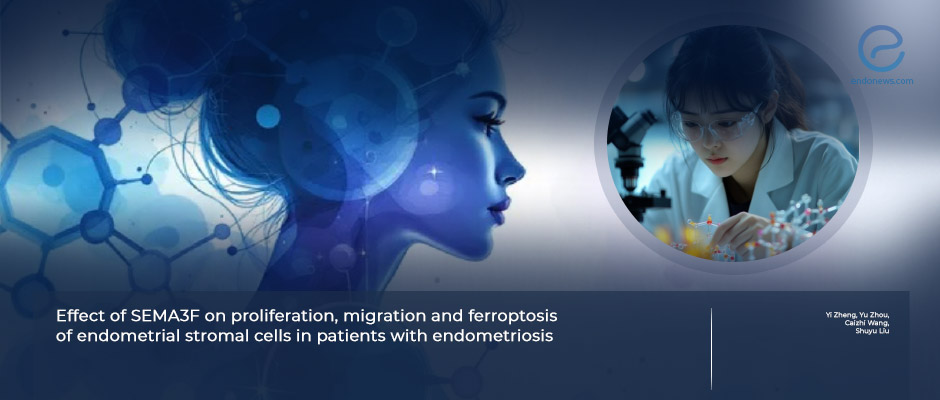Investigating SEMA3F in Endometriosis Pathogenesis
Jun 19, 2025
Targeting SEMA3F Signaling May Offer New Hope in Endometriosis Treatment
Key Points
Highlights:
- Semaphorin-3F (SEMA3F), a signaling protein, appears to suppress key cellular behaviors involved in the progression of endometriosis.
- It may influence both inflammation and ferroptosis, a regulated form of cell death implicated in disease pathogenesis.
Importance:
- The downregulation of SEMA3F in endometriotic lesions suggests a potential therapeutic target for limiting lesion proliferation and invasion.
- Modulating SEMA3F expression could pave the way for novel treatment strategies aimed at altering disease progression at the molecular level.
What’s done here:
- Researchers analyzed ectopic endometrial tissues from 30 patients with endometriosis and eutopic endometrial tissues from 30 control patients without endometriosis.
- Functional experiments were conducted on endometrial stromal cells to assess the effects of SEMA3F overexpression on cellular behavior, ferroptosis markers, and inflammatory responses.
Key results:
- SEMA3F expression was significantly lower in ectopic endometrial tissue versus eutopic controls, both at mRNA and protein levels.
- The overexpression of SEMA3F in endometrial stromal cells reduced cellular activity, migration, and invasion.
- The levels of certain markers of ferroptosis were significantly reduced, the expression of ferroptosis-related proteins was suppressed, and the levels of inflammatory markers were reduced when SEMA3F was overexpressed.
Strengths and Limitations:
- Strengths are, combined tissue-level analyses with cellular functional studies; and investigation of both ferroptosis and inflammation as mechanistic downstream pathways of SEMA3F.
- Limited sample size and absence of in vivo studies are limitations.
From the Editor-in-Chief – EndoNews
"This promising study sheds light on ferroptosis as an underexplored avenue in endometriosis research. The role of SEMA3F as a tumor suppressor now extends into the realm of gynecological pathology, linking cancer-like behavior with chronic benign disease. While early-stage, these findings warrant further in vivo studies and could inspire new therapeutic strategies beyond hormonal modulation. Targeting SEMA3F pathways may offer a novel, immune-safe approach for patients seeking fertility-preserving or long-term management options."
Lay Summary
Semaphorin-3F (SEMA3F), a protein that plays a role as a tumor suppressor, may control the development of endometriosis, according to a new study published in the scientific journal Gynecologic and Obstetric Investigation. It may do so by affecting the proliferation, invasion, and migration of endometrial stromal cells as well as their ferroptosis, or controlled death.
This study sheds new light on the biology of endometriosis, potentially opening up new avenues for the development of novel therapies against the disease.
To evaluate the potential role of SEMA3F in endometriosis, a team of researchers led by Dr. Shuyu Liu analyzed ectopic endometriotic tissues from 30 patients with endometriosis and eutopic endometrial tissues from 30 patients without endometriosis who had hysterectomy because of uterine fibroids.
The researchers measured the expression levels of SEMA3F in both sets of tissues. They then isolated endometrial stromal cells from the ectopic endometriotic tissues of the patients with endometriosis and quantified the expression of SEMA3F. They also analyzed the level of cell proliferation and assessed the levels of markers of ferroptosis, like Fe2+, malondialdehyde, and glutathione proteins related to ferroptosis, like acyl-CoA synthetase long chain family member 4 (ACSL4), and prostaglandin-endoperoxide synthase 2 (PTGS2). Finally, they measured the levels of inflammatory factors like interleukin 6 (IL-6) and tumor necrosis factor alpha (TNF-α).
The results showed that the levels of SEMA3F were lower in the ectopic endometrium compared to the eutopic endometrium, both at the mRNA and protein levels. In addition, the overexpression of SEMA3F in endometrial stromal cells diminished cellular activity, as well as cell migration and invasion. The levels of Fe2+, malondialdehyde, and other markers of ferroptosis were significantly reduced when SEMA3F was overexpressed, whereas the levels of glutathione were increased.
Finally, the expression of proteins related to ferroptosis was suppressed, and the levels of IL-6 and TNF-α were reduced when SEMA3F was overexpressed.
Research Source: https://pubmed.ncbi.nlm.nih.gov/40319865/
ectopic endometrium cell migration proliferation inflammation

